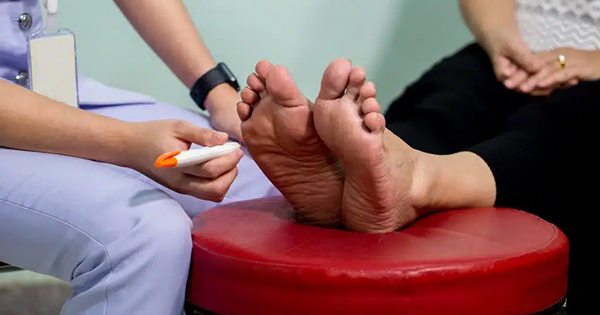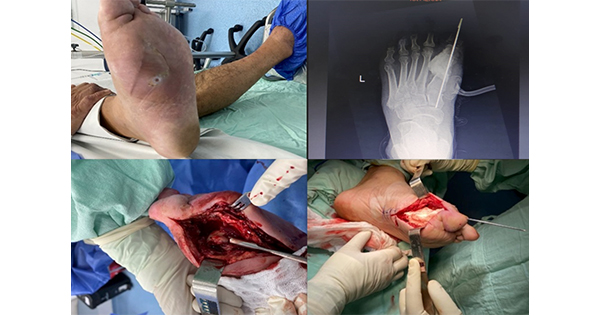Five per cent of people with diabetes in the UK experience a foot ulcer (NICE, 2015). Furthermore, “sixty per cent of diabetics, with foot ulcers develop infection and, as a result, up to 25% of these may have to undergo partial or full, lower-foot or lower-limb amputation,” according to Mooney (2013). It is estimated that £650 million is spent on diabetic foot ulcers and amputations each year in the NHS (Kerr, 2012; NICE, 2015). However, it is unclear why 25% of these patients had an amputation; it could be argued this is due to infection (Turner, 2013) and/or because of a lack of rapid access pathways, as Nice Guideline 19 advocates referral to the multidisciplinary foot team (MDFT) within 24 hours of admission. Turner (2013) highlighted that 80% of amputations are preventable, with rapid access being one of the main contributors to prevention.
In the UK alone, 100 people with diabetes have a lower-limb amputation a week, with costs to the NHS amounting to as much as £700 million per year (Holman et al, 2012). The cost to treat a foot ulcer is estimated at between £3,000 and £5,000 (Fard et al, 2007), with diabetic foot-related problems accounting for more hospital admissions than all of the other diabetic-related problems combined (Yarwood-Ross and Randall, 2013). This is also supported by Kerr (2012), who reported that the financial cost of diabetic foot care is between £1.75 million and £1.82 million per day.
Diabetes UK (2011), Moulton (2013) and NICE (2015) conclude that having a rapid access service can benefit the patient by reducing the risk of an ulcer developing further complications, such as infection, amputation and necrosis.
In response, diabetic foot screening has increased in trusts over the past year and this has been supported by a national initiative, the NICE guideline ‘Put Feet First’ (Turner, 2013).
Challenges for the NHS
The challenge for the NHS is to make financial savings at the same time as trying to meet the NICE guidelines. Mahaffey et al (2012) found that people with diabetes are admitted to hospital twice as often as people without diabetes and they occupy beds twice as long. They also reported that a saving of £35,000 was made over a 3-year period when people with diabetes were referred to the diabetic specialist nurse in the community and there was also a reduction in the amount of patients being admitted to hospital.
Current practice
Despite the high risk factors associated with diabetes and ulcers, and the emphasis placed on the need for preventative measures, Trusts were found to not be adhering to the previous NICE 2011 guidelines (McInnes, 2012). In addition, Trusts are not doing enough to prevent amputation (Jeffcoate and Rayman, 2011; McInnes, 2012). Staffing issues, capacity and cost-saving initiatives are reasons that could be attributed for the lack of adherence.
Where Trusts have introduced clear pathways for people with diabetes with an active ulcer to have rapid access to the MDFT, a reduction of 50% of amputations in hospitals has been seen (Moulton, 2013). Moulton’s (2013) findings are supported by North Mersey Diabetes Network (NMDN, 2011) and by the Diabetes UK (2013) report ‘Fast Track for a Foot Attack: Reducing Amputations’.
Aims
The aims of this pilot were to improve the accessibility to the podiatry service for all patients with diabetes with foot ulcers, and to meet the NICE NG19 standards (2015) for treatment of people with diabetes with skin lesions/ulcers.
Objectives
- To pilot a ‘drop-in’ diabetic foot ulcer clinic
- To audit the number and type of patients seen within the ‘drop-in’ diabetic foot ulcer clinic
- To audit the number of foot ulcer admissions to A&E and assess the impact of the ‘drop-in’ clinic on A&E.
Method
A pilot ‘drop-in’ clinic was opened for diabetic patients over an 8-week period (between December 2, 2014 and January 28, 2015). Eight emergency ‘drop-in’ appointments were made available between 8.30am and 11.30am on a Monday morning each week.
Data were collected from both the podiatry and A&E computer system for 8 weeks prior to the ‘drop-in’ clinic commencing and 8 weeks during the clinics. The number of foot ulcer admissions to A&E and to the podiatry department was recorded during this time period. In addition, a patient satisfaction survey was conducted at the end of each treatment during the pilot phase.
Results
Forty patients were treated during the 8-week ‘drop-in’ clinics. Seven had ulcers treated, one was pre-ulcerative, two had ingrowing toenails with infection, three had painful corns with risk of breakdown and the remaining 27 were deemed non-urgent.
Table 1 shows the patient satisfaction questionnaire that was handed out to patients, of which 80% (32/40) responded. It was also noted that all the respondents would recommend the service to family and friends.
Discussion
Benefits
Prior to the pilot, patients with ulcers firstly attended their GP surgery before being referred to the podiatry department. This resulted in a significant delay between the problem being detected and being treated. NICE NG19 standards (2015) and NICE Prevention and Management (2015) state that people with diabetes with a break in skin integrity must be seen by a specialist within one working day and this was achieved during the pilot. During this study, eight patients treated with ulcers were potentially prevented from developing further complications, such as amputation. Furthermore, by using the NICE NG19 standards (2015) as a template, the authors were able to produce a clear pathway and a standard operating procedure for diabetic foot ulcers.
Admissions of diabetic foot ulcers to A&E reduced during the pilot and, as a result, there were reduced waiting times and improved patient satisfaction within A&E. However, there were variables that could have affected the reliability of the data collected from A&E due to different computer systems operating within podiatry and A&E. This was a limitation of the project. Similar issues were also identified within the literature, for example, coding issues (Royal College of Nursing, 2013) and incompatible systems (Pope et al, 2013). This results in non-comparable data, which means impact data are difficult to extract. Therefore, the impact of the ‘drop-in’ clinic could be more significant than the figures suggest (i.e. the number of people with diabetes and ulcers could be under-recorded).
Patient satisfaction with the ‘drop-in’ clinic was high (91% rated care as ‘excellent’ and 9% as ‘good’). An example of the clinical impact was a patient who, having discharged himself from hospital due to the treatment he received, attended the clinic with a seriously infected ulcer that could be probed to the bone. With treatment that included intravenous antibiotics, a potential below-knee amputation was avoided. The action taken not only impacted positively on the patient’s quality of life, but impaced positively in financial terms, as this represented a potential saving to the NHS of £35,000 on amputation costs (Mahaffey et al, 2012; Moulton, 2013). In total, eight ulcers were treated, which had they been left longer than 24 hours, might have deteriorated and developed further complications.
The long-term impact of the ‘drop-in’ clinic was twofold; the quality of life for those patients with ulcers improved and there are potential savings of over £100,000 in amputation costs per hospital (Nason et al, 2012). It was also noted that further savings could be made as people with diabetes are admitted to hospital twice as often as patients without diabetes (Mahaffey et al, 2012); they have extended stays in hospital with unknown associated costs (Stang and Munro, 2015) and it has been estimated that the cost to treat an individual ulcer is between £3,000–£5,000 (Fard et al, 2007). Furthermore, North Mersey Diabetes Network (NMDN, 2011) stated that when a patient is seen by a member of the multidisciplinary footcare services within the recommended 24-hour period, the chance of preventing further complications is increased. Therefore, the right care and treatment can reduce the risk of amputations and the length of hospital stay (NICE, 2015).
Challenges
The unintended outcomes of the pilot were that 27 non-urgent patients were seen (representing 67% of the total number of patients). The reasons for this could be a lack of patient understanding about what is classed as ‘urgent’ for people diabetes and also the purpose of the ‘drop-in’ clinic (Diabetes UK, 2011; NICE, 2011; NMDN, 2011). In order to further develop the clinic and prevent this scenario from reoccurring, better patient education for people with diabetes is required, as well as clear inclusion and exclusion criteria for the ‘drop-in’ clinics.
A patient satisfaction survey reported that 87% of the patients expressed a need for the clinic more than once a week because of the rapid access. Patients reported themes such as: it was ‘easier and better for them’; that they could just ‘turn up’ for an appointment; and that they found the current system of booking a routine treatment ‘inefficient’. These findings resonate with patient complaints; the fact that they ‘find it hard to get an appointment on the same day they phone’ (Murdock et al, 2014). It is worth noting that these reasons could be the catalysts that make such a high number of non-urgent patients attend the ‘drop-in’ clinic. It is clear that, in addition to further expanding the clinic, the booking system of routine treatment needs to be improved.
Conclusion
The aim of improving the accessibility of the podiatry service for all people with diabetes and foot ulcers in order to meet NICE NG19 standards (2015) was achieved. This was evidenced through the audits completed prior and during the ‘drop-in’ clinics. Patient satisfaction indicated positive experiences for all patients in terms of quality of care and treatment. There was a positive impact on the A&E department as there were fewer patients to treat and, thus, waiting times reduced. A clear pathway and standard operating procedure was established for diabetic foot ulcer patients. Furthermore, there are clear potential cost savings to be made, in terms of ulcer prevention/management and costly amputation, especially if clinicians have access to a multidisciplinary foot care service (NICE, 2015).
Recommendations
Sixty-seven per cent of patients assessed within the ‘drop-in’ clinic were non-urgent. Therefore:
- A ‘drop-in’ clinic should be available for all existing diabetic patients who are concerned about their feet
- Structured education should be available to help patients understand their condition and the appropriate pathway for treatment
- It is recommended that a patient information leaflet is developed to explain the ‘drop-in’ clinic inclusion/exclusion criteria and what is classed as ‘urgent’
- To extend the clinic to other long term conditions as recommended by the Department of Health (2008)
- Research is required to explore whether organisations are meeting the NICE NG19 standards (2015) for the treatment of people with diabetes who have a break in the skin and then enable the sharing of best practice.





